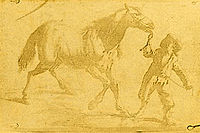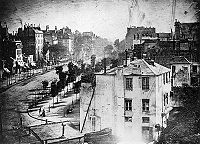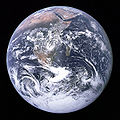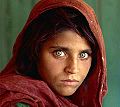Course:ETEC540/2009WT1/Assignments/ResearchProject/Photography
ETEC 540 students, please add your most memorable photo here. You can add photographs that are widely recognized or ones that have inspired you. I used Creative Commons to find my images. Thanks for your time, Sarah
-
V-J Day Kiss in Times Square, 1945
-
Tianamen Square, 1989
-
Kim Phúc, Vietnam, 1972
-
Blue Marble, taken by crew of Apollo 17, 1972
-
Afghan Girl, 1972
-
The Falling Man, 9/11
== Photography: Historical and Cultural Impact ==
“Photography, which most people thought of as a neutral window on the world, now appears more like the distorting mirror of our own perceptions” (James, 1989).
Photographs evoke emotion and induce inquiry. At one time or another we have all been awestruck by something we have seen in a photograph. We cannot hear a photo, we cannot smell a photo, yet a well shot photo can stimulate a full range of emotions. Photograph comes from the Greek words φῶς (phos) meaning light and γραφή (graphê) meaning drawing or representing lines (Wikipedia, 2009). In its simplest form, a photograph captures light. The “process, practice, or art of taking photographs” is known as photography (Oxford English Dictionary, 2009). Photography has evolved from its roots of simply capturing light to an art form that is used to communicate messages. Jay David Bolter, in his book, Writing Spaces, calls the shift “remediation” when one medium takes place of another medium (2001). Photography created a new visual language’ it has altered written discourse and has brought new words and ideas into our lexicon. This paper intends to explore how photography, as a communication medium, plays a dominate role in our society today and to fully understand its impact we need to look back to its history.

Interestingly, the art of photography started out more as a science; a technical evolution that comprised a series of technical advancements rather than a breakthrough innovation. In 1827, Joseph Nicephore Niepce made the first photographic image, but it is Louis Daguerre who showed the world his image in 1839 that is credited as the inventor of photography (Marien, 2002). Both Niepce and Daguerre worked together until Niepce’s death to develop the technology that would lead to Daguerre’s photo. There is some dispute among historians if the advent of photography is linked to the technical changes of the Industrial Revolution (Marien). Marien argues that camera production did not start until 1855 when the commercial demand for photographs grew and thus the invention of the photography should not be linked the Industrial Revolution.
There was much mystique around photography in the beginning as it was not possible to duplicate or alter the original in any way (Srivatsan, 1991). People took what they saw at face value as they believed that the photograph was a true representation of what was shot. Take for example the first photograph of a person ever shot in 1838: [Boulevard du Temple] [1]by Daguerre.

In the image, the streets are empty and there appears to be only one man on the sidewalk. In reality, the streets were busy with traffic and the sidewalk was busy with people, but due to the long expose time (10 min) only the man getting his shoes polished was captured. In her highly acclaimed book, Photography: A Cultural History, Mary Warner Marien states, in the early years “advocates of photography’s potential tended to ignore the ways in which the photograph was not an objective view but a series of choices” (2003, p.xiv). Like written work, the photographer can manipulate an image to show (or more importantly, not show) what message that they want the viewer to witness. As photography evolved, people came to understand that it was not the “neutral window” as first hypothesized. As photography become more popular, it started to find its place in society and people had to define its medium.
Photography has a mixed history as society was unsure if a photograph was “an original, intellectual conception of the author”, an art, or the production of a “soulless” machine (Farley, 2003, p.385).

In 1884, the Supreme Court saw its first copyright case surrounding a photograph, Burrow-Giles Lithographic Co. v. Sarony (Farley). Napoleon Sarony filed suit against the company who had used his photograph. He felt the photograph was his creation and thus should follow the same copyright laws as written work. The company on the other hand argued that the photograph was “produced directly by technology” and should not be protected (Farley, p.389). The courts ruled that photographs are authored and that they represent the ideas of the photographer and thus they should be protected. This is a monumental development in photography’s history as it created a cultural shift of how society viewed photography. Photography was now seen as a communication medium that was created by humans and not controlled by machines. Society realized that photographs could tell the story of an author just as words on a page are able to.
Photography created an image-based culture whereby average people could bare witness to events directly. Photography is a visual language that both literate and illiterate people could use to communicate what was happening in the world. Photography has the power to unite people for social change. Lloyd Eby (1999) points out that before photography, war was romanticized in written and oral accounts. But as society viewed war images the brutality of war was exposed; society’s perception and opinion of war had changed due to photography. Eby comments, “photographs and newsreels were mostly banned from World War I because the political and military leaders knew that allowing the war to be seen would lead to a loss of support for their war efforts (p.30). Photography has the power to impact human thoughts and actions. In more recent times, the images of starving children in Africa have been played on TV and in classrooms to evoke an emotional response and hopefully elicit action in helping these children. Srivatsan comments, “Photographic vision has a way of penetrating any discourse and powerfully reconstituting its logic and practice” (p.771). Photography is a more powerful medium than written or oral discourse to communicate messages of social importance. The visual stimulus forces people to look and decide for ourselves what the truth is.
Visual literacy has now entered our vernacular and no longer do we accept that a photograph is a “conviction of fact” (Goin, 2001, p.363). According to Wikipedia (2009), "Visual literacy is the ability to interpret, negotiate, and make meaning from information presented in the form of an image. Visual literacy is based on the idea that pictures can be “read” and that meaning can be communicated through a process of reading." As teachers we train students to look past what is seen in an image and situate it both culturally and historically. We now realize that an image only tells part of the story. Please watch the YouTube video “Visual Literacy Across the Curriculum” as it attempts to encourage teachers to use visual imagery in their classrooms.
Photography may have succeeded in “freezing the present tense forever” but it has changed the way that we can communicate permanently (James, 1989). The invention of photography created a new visual language that transcended oral and written communication. Photography reduces language barriers and no longer requires the audience to be literate to decipher the message. The remediation of photography continues as photographs can be easily manipulated by computers. We realize that photography is not a neutral window, but an art form or a communication medium that opens our eyes to the world around us.
References:
Eby, L. (1999). In the mind’s eye: our emerging visual culture. World & I, 14(9), 22-31. Farley, C.H. (2003). The lingering effects of copyright's response to the invention of photography. University of Pittsburgh law review, 65(2), 385-456.
James, G. (1989). 150 years of photography. Maclean’s, 102(17), 36.
Oxford English Dictionary. (2009). Photography definition. Retrived October 9, 2009 from http://www.oed.com/.
Marien, M.W. (2006). Photography: a cultural history. London: Laurence King Publishing.
Srivatsan, R. (1991). Photography and Society: Icon Building in Action. Economic and Political Weekly, 26(11/12), 771-788.
Wikipedia. (2009). Photography definition. Retrieved October 9, 2009 from http://en.wikipedia.org/wiki/Photograph.





